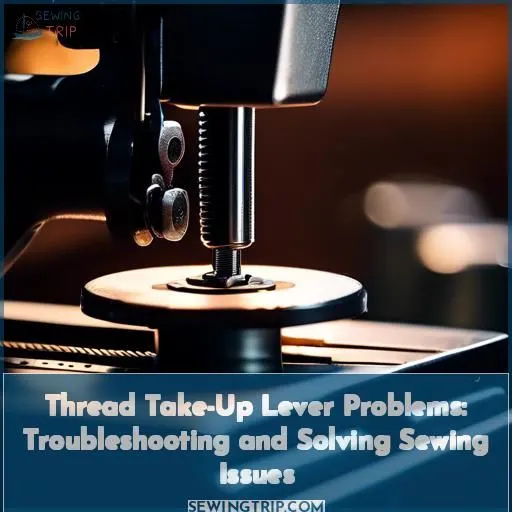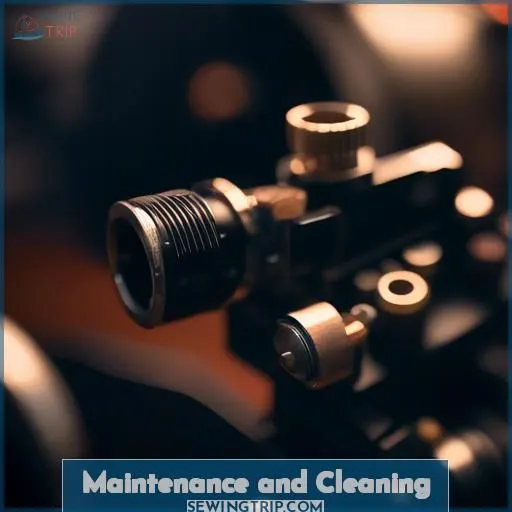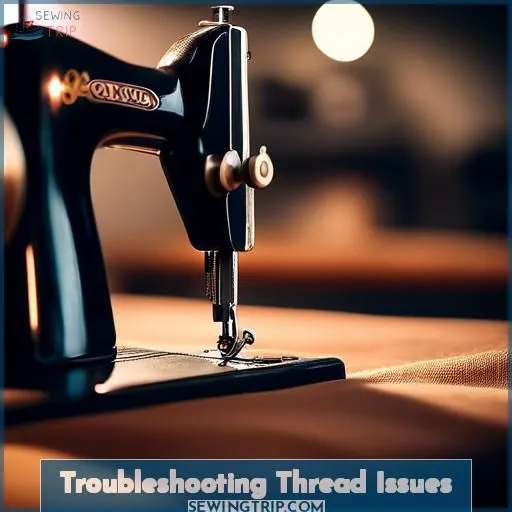This site is supported by our readers. We may earn a commission, at no cost to you, if you purchase through links.
Experiencing thread take-up lever issues?
They could arise from improper tension, hook timing problems, or thread slippage.
Thoroughly clean the thread path, release mechanism, and tension assemblies, removing any buildup.
Regularly replace the needle and fine-tune the lever’s spring action.
Troubleshoot by confirming correct thread routing, tension adjustments, and using polyester monofilament thread.
Make sure the hook wraps thread around the bobbin case when the take-up lever is at its lowest position; adjust synchronization as necessary.
By addressing these factors, you’ll uncover the underlying causes and restore smooth operation.
Explore in-depth solutions for a complete understanding.
Table Of Contents
Key Takeaways
- Properly clean the thread path, release mechanism, and tension assemblies to remove any buildup.
- Regularly replace the needle and fine-tune the lever’s spring action.
- Confirm correct thread routing, tension adjustments, and use polyester monofilament thread.
- Adjust synchronization as necessary to ensure the hook wraps the thread around the bobbin case when the take-up lever is at its lowest position.
Thread Take-Up Lever Problems
Thread take-up lever problems can be a common issue when sewing, especially on machines like the Viking Designer SE. These problems often arise due to incorrect thread tension, hook timing, or tension unit issues. To troubleshoot these problems, it’s imperative to make sure the thread is through all guides and check the tension, which should be around 4. Using monopoly thread instead of clear thread can also help prevent the thread from jumping out. Additionally, keep the presser foot up when threading and use polyester monofilament thread instead of nylon clear thread.
If the thread keeps coming out of the take-up lever, it may be due to holding the thread ends incorrectly when starting to stitch, using an incorrect needle size, ignoring tension settings, or thread getting caught in rough areas. To prevent these issues, use felt under the thread spool, flip the thread spool around, or use a tall thread stand. Guarantee that the take-up spring is moving correctly and check for rough areas on the machine.
Incorrect hook timing can also cause the thread to be pulled through at the wrong moment, leading to snagging or incorrect timing. This can be addressed by adjusting the hook timing or using a timing adjustment tool. Remember to clean the machine after every project, change the needle frequently, and oil the machine regularly. By following these tips, you can resolve thread take-up lever problems and improve your sewing experience.
Maintenance and Cleaning
To preserve your sewing machine and avert thread take-up lever issues, consistent cleaning and oil changes are vital.
Commence by cleaning the thread release mechanism and tension assemblies. Remove any dust or debris from the thread path and tension assemblies.
Routinely replace the needle to ensure proper thread movement.
Inspect the spring action in the thread take-up lever and adjust tension accordingly.
Use felt beneath the thread spool and reverse it to prevent thread from tangling.
Maintain your machine’s cleanliness after each project, change the needle frequently, and lubricate it regularly.
Schedule annual servicing appointments for expert cleaning and maintenance.
These measures will assist you in maintaining your sewing machine and preventing thread take-up lever complications.
Troubleshooting Thread Issues
Regarding troubleshooting thread problems on your Viking Designer SE machine, several aspects warrant attention.
First, verify that the thread is routed correctly through all the necessary channels, including the tension unit and the bobbin case. Review the tension settings, which should ideally be around 4, to avert the thread from falling out. If you’re using clear thread, contemplate switching to a more dependable option like polyester monofilament thread, which is less susceptible to jumping out. Remember to lift the presser foot during threading to prevent any potential tangles or snags.
To further preclude thread from falling out, utilize a felt pad under the thread spool or invert the spool to guarantee even tension. A tall thread stand can also facilitate maintaining proper thread path. Inspect your machine for any rough areas that might be causing friction and adjust the hook timing if required. Regular maintenance, such as cleaning after each project, frequently changing needles, and lubricating the machine regularly, can also assist in preventing thread issues.
Thread Take-Up Lever Timing
Thread take-up lever synchronization is paramount for preserving the correct alignment and tension of your sewing machine’s thread. The take-up lever isn’t adjustable, but its synchronization is determined by the needle bar movement. To guarantee accurate synchronization, the hook should draw the thread around the bobbin case when the take-up lever is at its lowest point. If the hook is synchronizing incorrectly, it can induce the thread to be drawn through the tension unit at the incorrect moment, resulting in issues like snagging or thread breaking.
To rectify these issues, you may need to adjust the hook synchronization. This can be done by examining the spring and bobbin case opener, verifying their proper functioning. If the hook position is misaligned, you may need to adjust the hook timing. Regrettably, it isn’t feasible to adjust the take-up lever synchronization directly. However, regular machine maintenance, such as cleaning after each project, replacing needles often, and lubricating the machine, can aid in preventing thread issues. Additionally, scheduling annual maintenance visits can ensure your sewing machine is operating at its optimum.
Frequently Asked Questions (FAQs)
How can I prevent the take-up lever from coming out of the take-up lever on my Viking Designer SE machine?
You’ve got a stubborn take-up lever, my friend! Try flipping the thread spool, or use a thread stand – that extra lift can work wonders. And don’t forget to check for any rough patches that could be snagging your thread. A little TLC goes a long way with these vintage beauties.
What is the recommended tension setting for the take-up lever on a Viking Designer SE machine?
Hey there, sewing enthusiast! Like a well-oiled machine, the ideal tension for your Viking Designer SE’s take-up lever is around 4 – just tight enough to create a harmonious stitch without any hiccups.
How can I ensure that the thread does not jump out of the take-up lever during sewing?
Check your timing, mate. If it’s off, the thread’ll jump that take-up lever like a kangaroo on caffeine. Get that hook synced right, and she’ll glide through smooth as butter.
What is the difference between using polyester monofilament thread and nylon clear thread for sewing?
Imagine thread as a diva – polyester monofilament is the graceful ballerina, while nylon’s the petulant starlet who can’t stay on her mark. Polyester glides obediently through guides; nylon careens off course, yielding snags and tantrums. Choose poise over drama for flawless stitches.
How can I adjust the hook timing on my Viking Designer SE machine to prevent thread issues?
You’ll need to adjust the hook timing, ensuring it pulls the thread only when the take-up lever is at its lowest point. This intricate dance prevents excess thread from sneaking through the tension discs prematurely. With a deft touch and a keen eye, you can orchestrate seamless stitches once more.
Conclusion
Like an adept surgeon, you’ve precisely resolved thread take-up lever issues by diligently cleaning, calibrating tension, exchanging components, and refining timing. With synthetic thread and optimal hook alignment, your sewing machine operates seamlessly, preventing exasperating thread difficulties. Remain attentive to maintenance; your unwavering dedication guarantees pristine stitching perpetually.










